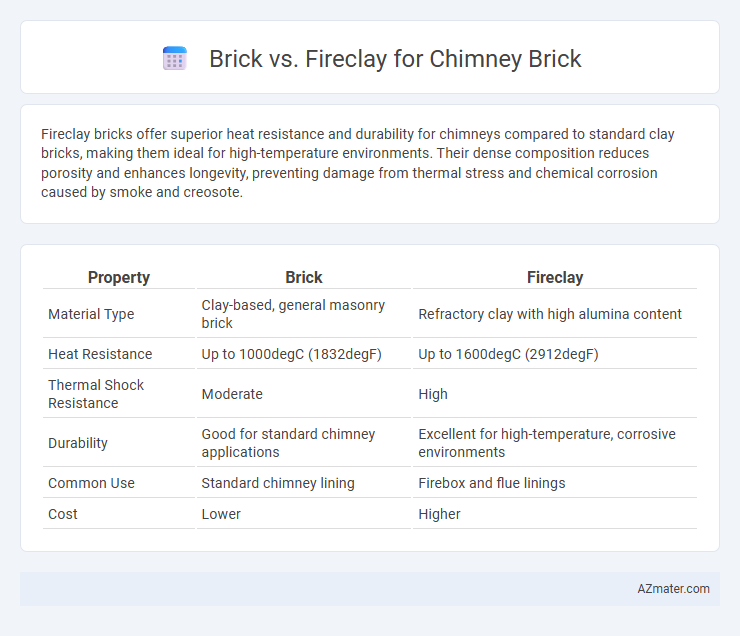Fireclay bricks offer superior heat resistance and durability for chimneys compared to standard clay bricks, making them ideal for high-temperature environments. Their dense composition reduces porosity and enhances longevity, preventing damage from thermal stress and chemical corrosion caused by smoke and creosote.
Table of Comparison
| Property | Brick | Fireclay |
|---|---|---|
| Material Type | Clay-based, general masonry brick | Refractory clay with high alumina content |
| Heat Resistance | Up to 1000degC (1832degF) | Up to 1600degC (2912degF) |
| Thermal Shock Resistance | Moderate | High |
| Durability | Good for standard chimney applications | Excellent for high-temperature, corrosive environments |
| Common Use | Standard chimney lining | Firebox and flue linings |
| Cost | Lower | Higher |
Introduction: Understanding Brick and Fireclay for Chimneys
Fireclay bricks are made from high-temperature refractory clay and are designed to withstand intense heat, making them ideal for chimney linings. Standard clay bricks, while durable and commonly used in construction, do not offer the same thermal resistance as fireclay bricks, which can tolerate temperatures above 1,500degF (815degC). Choosing the right material for chimney construction ensures safety, longevity, and efficient heat management.
Material Composition: Brick vs Fireclay Explained
Brick chimneys are primarily made from clay and shale, fired at high temperatures to create durable, porous materials that withstand heat and weathering. Fireclay bricks contain a higher concentration of alumina and silica, enhancing their heat resistance and making them ideal for lining chimneys exposed to intense temperatures. The superior thermal stability of fireclay bricks reduces the risk of cracking and deterioration, providing longer-lasting protection compared to standard brick materials.
Heat Resistance Capabilities
Fireclay bricks exhibit superior heat resistance capabilities compared to traditional bricks, making them ideal for chimney construction where high temperatures are consistently present. These bricks are specifically engineered to withstand extreme thermal stress without cracking or deteriorating, ensuring long-lasting performance in flue environments. In contrast, conventional bricks may not offer the same level of heat durability, potentially leading to faster degradation and maintenance issues in chimneys exposed to intense heat.
Durability and Longevity
Fireclay chimney bricks exhibit superior durability compared to traditional clay bricks due to their high resistance to heat and chemical corrosion, making them ideal for withstanding intense chimney environments. These bricks maintain structural integrity over extended periods, resisting cracking and spalling caused by thermal cycling and acidic flue gases. In contrast, standard clay bricks may degrade faster under similar conditions, potentially requiring more frequent maintenance or replacement.
Installation: Ease and Techniques
Fireclay bricks offer greater ease of installation for chimney construction due to their uniform size, smooth texture, and consistent shape, which allows for precise mortar joints and quicker laying times. Traditional brick requires more skill and time to install, as its irregular surface and varying sizes necessitate careful alignment and additional mortar adjustments to ensure structural integrity. Both materials benefit from experienced masons, but fireclay's workability reduces labor intensity and streamlines the chimney building process.
Maintenance Requirements
Fireclay chimney bricks require less maintenance due to their superior resistance to heat, chemicals, and weathering compared to traditional clay bricks. While clay bricks may need frequent inspections and occasional repointing to address cracking or spalling caused by thermal cycles, fireclay bricks maintain structural integrity longer and reduce the frequency of repairs. Regular cleaning to prevent soot buildup remains necessary for both materials to ensure optimal chimney performance and safety.
Cost Comparison
Fireclay bricks typically cost 30-50% more than standard clay bricks due to their higher heat resistance and durability, making them a premium choice for chimney construction. Standard clay bricks generally range from $0.50 to $1.50 per brick, whereas fireclay bricks can cost between $1.00 and $3.00 each. While fireclay bricks have a higher upfront cost, they often reduce long-term maintenance expenses and enhance chimney longevity, potentially offsetting the initial investment.
Aesthetic Differences
Fireclay chimney bricks exhibit a smooth, uniform finish with richer color variations, creating a more polished and refined aesthetic compared to traditional bricks. Traditional bricks offer a more rustic and textured appearance, showcasing natural imperfections and weathered charm that appeal to classic or historic designs. Choosing between fireclay and traditional brick depends on the desired visual impact, with fireclay enhancing modern elegance and traditional brick emphasizing timeless authenticity.
Safety and Code Compliance
Fireclay bricks offer superior heat resistance and durability compared to standard bricks, making them ideal for chimney construction to withstand high temperatures safely. Building codes often require the use of fire-resistant materials like fireclay bricks for chimney liners and flues to prevent fire hazards and ensure structural integrity. Compliance with local safety regulations mandates selecting materials with proven thermal stability, which fireclay bricks provide, reducing the risk of chimney fires and carbon monoxide leaks.
Choosing the Right Material for Your Chimney
Fireclay bricks offer superior resistance to high temperatures and chemical corrosion, making them ideal for chimney linings exposed to intense heat and acidic byproducts. Standard bricks, while more affordable, may lack the durability required for long-term chimney use and are more prone to cracking under thermal stress. Selecting fireclay bricks enhances chimney safety and longevity by providing better insulation and structural integrity in harsh flue environments.

Infographic: Brick vs Fireclay for Chimney brick
 azmater.com
azmater.com